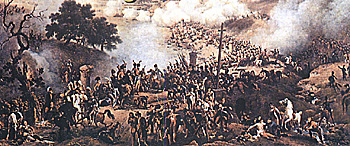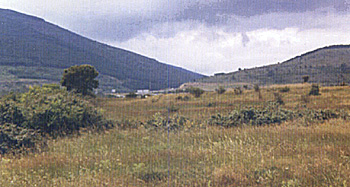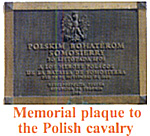Battle of Somosierra
30 November 1808
The Charge of the
Polish Light Horse
by Robert Burnham, USA
| |
In 1808, despite the efforts of some of his best Marshals, the war in Spain was not going as Napoleon envisioned. The ragtag Spanish army was holding on throughout the country, cities were in open insurrection, Napoleon's brother Joseph whom he had hoped to place on the Spanish throne had to evacuate the capital, and a French army had been forced to surrender at Baylen. By the fall, Napoleon decided to intervene personally and settle the matter once and for all. Moving swiftly, the Emperor, were almost at the gates of Madrid by November 30. All he had to do was to move through the Sierra de Guadarrama, a mountain range between 1,500 and 2,000 meters high and Madrid would be his!
The main north-south road from Burgos to Madrid went through the Somosierra Pass, which was about 1400 meters high. The narrow road wound for three kilometres from the northern plains to the top of the pass. It crossed numerous small streams and but a relatively gentle climb.
To which Napoleon replied "Impossible! What! My guards stopped by peasants! By armed bands!" He then ordered Philippe de Segur ". . . Go at once, make my Poles charge, make them take everything, or bring me back prisoners!"
De Segur's Account of the Charge
The following is the de Segur's account of the charge:
". . . I arrived at the foot of rock under shelter of which the Polish squadron was drawn up alone, in front of the infantry. 'Commandant,' I cried to Korjietulski, 'the Emperor orders us to charge home, and at once!' Upon which Montbrun made an exclamation and a gesture of astonishment without venturing to contradict me; but Pire answered: 'It is impossible!' -- 'The Emperor has been told that,' I retorted, 'and he will not hear of it.' - 'Very well,' resumed Pire, 'come and see for yourself; the devil in person, pretty well used to fire as he must be, could hardly stand that!' Then to prove the truth of his words, advancing beyond the rock through a hail of bullets which rained down upon our equipments, he pointed out to me the steep slope of the road up to this amphitheatre bristling with rocks, the redoubt of sixteen guns which crowned it, and twenty battalions deployed in such a manner as to converge their front and flank fire on an attack which could only be effected in column and along the road . . . 'It does not matter,' I exclaimed; 'the Emperor is there and he insists on the thing being settled. Come, Commandant, the hour will be ours, advance by squads, and forward!' . . . I had hardly had time to draw my sword from my scabbard, before they had begun their charge in a column . . . We charged at full speed, I was about ten paces in front with my head bent down, uttering our war cry by way of distracting my attention from the din of the enemy's fire which was all breaking out at once and the infernal hiss of their bullets and grape shot. Reckoning on the rapidity of our impetuous attack, I was hoping that in their astonishment at our audacity the enemy would aim badly; that we should have time to dash into the midst of their guns and bayonets and throw them into disorder.
But they aimed only too well! Very soon, in spite of our clamour and the detonation of so many arms, I could distinguish behind me the sound of smart reports followed by groans, with the thud of falling men and horses, which made me foresee defeat. Our warlike cries were becoming lost in the cries of pain of the unfortunate Poles; I did not dare to turn my head, fearing that the sad spectacle would cause me to give up. I knew that I had been struck several times . . . I was alone within thirty paces of the redoubt. I had outstripped two battalions of the enemy, place obliquely, behind a ravine on our right flank. One officer alone was following me, Rudowski, I believe, a colossus, like most of these picked men. He was still on horseback, but wounded to death, staggering, and on the point of falling off with his face to the enemy. Distance and the rocks prevented my seeing anything more. I made a vain attempt to turn back my horse, which was itself wounded; but the Spaniards advanced to seize me, shouting cries of victory.
Then I jumped to the ground trying to collect what strength remained to me . . . Nearly the whole of the squadron was laid low. Out of six other officers, three were either killed outright or mortally wounded . . . The three others. . . were wounded. Forty non-commissioned officers and lancers, killed or mortally wounded, were lying on the ground. Twelve others were wounded but less serious; twenty alone had escaped this massacre safe and sound. These had assisted their wounded to retire, so that, over the whole of the remaining ground covered by our charge I only saw one trumpeter left standing, motionless in the midst of the firing which was still going on. The poor child was weeping for his squadron . . ."
Seven Minutes
The charge was over in seven minutes and despite the gallantry of the cavalry, the Spanish still held. In a short while, the French infantry had reached the summit of the hills overlooking the pass and outflanked the guns. Napoleon ordered the 1st and 2nd Squadrons of the Polish Light Horse, along with the Chasseurs-a-Cheval of the Guard forward and this time the guns were taken. The pass was in the hands of the French and the way to Madrid was open.
The Emperor was soon at the top of the pass. Seeing Lieutenant Niegolewski lying besides the guns he tried so valiantly to capture, the Emperor pinned his own Legion of Honour on him.
Two days later, Dezydery Chlpowski, a Polish officer assigned to the Emperor's Headquarters passed over the battlefield. ". . . There were still several bodies of Polish light horsemen in the snow, which continued to cover the summit of Somosierra. We stopped for half an hour in the village of Somosierra, where we found some severely wounded men who had not yet been transported. They told us about the charge by Dziewanowski's squadron, claiming all the officers and over half the men had been killed . . . They assumed Lieutenant Niegolewski would also have died, as he had been badly wounded. While we were there, ambulances came to take the rest of the wounded to Madrid. From one of the surgeons I learned that as a reward for the charge of Somosierra the Emperor had promoted the whole Polish Guard regiment to the Old Guard. This meant it had skipped the Middle Guard, as normally a regiment would go from the Young to Middle and only after another act of heroism should it go to the Old Guard... So the Emperor, who witnessed the charge at Somosierra, must have thought it very fine to promote the regiment straight from Young to Old Guard, and he also ordered the whole Guard to present arms to the squadron as it passed by."
Of the eight officers who charged that day, four were killed or died of their wounds, while the other four were wounded. Despite the pessimism of the wounded soldiers, Niegolewski survived his wounds and was still alive in 1855! De Segur was wounded five times and took six months to recover from them.
Unfortunately the Somosierra battlefield has been ruined by the construction of the N1 four-lane highway that runs through the pass. This highway has straightened out most of the winding road that is described in all of the memoirs but still follows the general direction of the old road. The best view of the pass from the Spanish position can be seen from the small chapel located next to the hotel at the top of the pass. However it is very difficult to see much of the pass without climbing into the hills on either side of it.
How To Get To The Battlefield
Somosierra: From Madrid, go north on N1 for about 100 km. Look for the signs for Robregordo. Exit from the main highway and follow the road until you arrive at the hotel at the top of the pass.
Chlapowski, Dezydery. Memoirs of a Polish Lancer Chicago: Emperor's Press; 1992.
This article was first published in the "Napoleon Series"; a web site dedicated to the study of the Napoleonic Wars. It can be found at: www.napoleonseries.org
|
 One of the legends that have come out of the Napoleonic Wars is the charge of the Polish Light Horse Regiment of the Imperial Guard at Somosierra, Spain on 30 November 1808. The affair in itself was relatively insignificant and would be forgotten by most, except for the valour of the troops involved.
One of the legends that have come out of the Napoleonic Wars is the charge of the Polish Light Horse Regiment of the Imperial Guard at Somosierra, Spain on 30 November 1808. The affair in itself was relatively insignificant and would be forgotten by most, except for the valour of the troops involved.
 A reconnaissance by Major Lejeune revealed the pass was held in depth and a Spanish prisoner-of-war stated that the pass was defended by 9,000 infantry and 16 artillery pieces. The Emperor ordered General Montbrun and Colonel Pire, Berthier's aide-de-camp, to charge with the 80 Polish light horsemen who formed his duty escort. This charge was stopped almost immediately. When Colonel Pire informed Napoleon that it was impossible to take the pass with cavalry, Napoleon exploded and ". . . violently striking the pommel of his saddle he exclaimed: 'How, impossible? I do not know the word! There should not be anything impossible for my Poles!" General Walther, the commander of the Guard, advised Napoleon that his infantry was moving up the steep hills on either side of pass, and would soon outflank the Spanish positions.
A reconnaissance by Major Lejeune revealed the pass was held in depth and a Spanish prisoner-of-war stated that the pass was defended by 9,000 infantry and 16 artillery pieces. The Emperor ordered General Montbrun and Colonel Pire, Berthier's aide-de-camp, to charge with the 80 Polish light horsemen who formed his duty escort. This charge was stopped almost immediately. When Colonel Pire informed Napoleon that it was impossible to take the pass with cavalry, Napoleon exploded and ". . . violently striking the pommel of his saddle he exclaimed: 'How, impossible? I do not know the word! There should not be anything impossible for my Poles!" General Walther, the commander of the Guard, advised Napoleon that his infantry was moving up the steep hills on either side of pass, and would soon outflank the Spanish positions.
 The chapel has on its wall a memorial plaque to the Polish cavalry. To get the French view, get back on N1 and head north until the next exit. Stop along the road and look south.
The chapel has on its wall a memorial plaque to the Polish cavalry. To get the French view, get back on N1 and head north until the next exit. Stop along the road and look south.